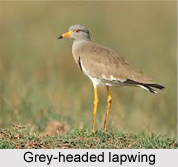 Grey-headed lapwing is an Indian Bird that bears the scientific name "Vanellus cinereus", haling from the lapwing species. The global population is estimated to number 25,000-100,000 individuals, 50 individuals on migration and 50 wintering individuals in Taiwan; 1,000 individuals on migration in Korea and 100-10,000 breeding pairs, 50-1,000 individuals on migration and 50-1,000 wintering individuals in Japan. The population of Grey-Headed Lapwing is suspected to be in decline owing to ongoing habitat destruction and degradation of forests and the ecological balances.
Grey-headed lapwing is an Indian Bird that bears the scientific name "Vanellus cinereus", haling from the lapwing species. The global population is estimated to number 25,000-100,000 individuals, 50 individuals on migration and 50 wintering individuals in Taiwan; 1,000 individuals on migration in Korea and 100-10,000 breeding pairs, 50-1,000 individuals on migration and 50-1,000 wintering individuals in Japan. The population of Grey-Headed Lapwing is suspected to be in decline owing to ongoing habitat destruction and degradation of forests and the ecological balances.
Breeding Season of Grey-Headed Lapwing
Grey-Headed Lapwing is a lapwing species which breeds in northeast China and Japan. The mainland population winters in northern Southeast Asia from north-eastern India to Cambodia. The Japanese population winters, at least partially, in southern Honshu.
This species has occurred as a vagrant in Russia, the Philippines, Indonesia and New South Wales of Australia. The mainland population of Grey-Headed Lapwing migrates in winter in northern Southeast Asia from north-eastern India to Cambodia.
Structure of Grey-Headed Lapwing
Grey-Headed Lapwing is 34-37 cm long. It has a grey head and neck, darker grey breast band and white belly. The back is brown, the rump is white and the tail is black. This is a striking species in flight, with black primaries, white under wings and upper wing secondaries and brown upper wing coverts.
Structure of Grey-Headed Lapwing
The adult Grey-Headed Lapwings of both sexes are similarly plumaged, but males are slightly larger than females. The young birds have the white areas of plumage tinged with grey, a less distinct breast band, and pale fringes to the upper part and wing covert feathers.
Sounds of Grey-Headed Lapwing
The call of Grey-Headed Lapwing is a sharp chee-i.
Nests of Grey-Headed Lapwing
Grey-Headed Lapwing nests from April to July in wet grassland, rice fields and marshland edges. It winters in similar habitat and is then gregarious. It feeds in shallow water on insects, worms and molluscs.



















